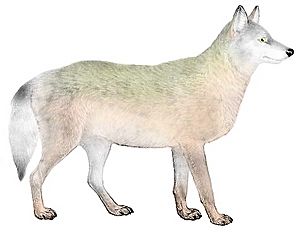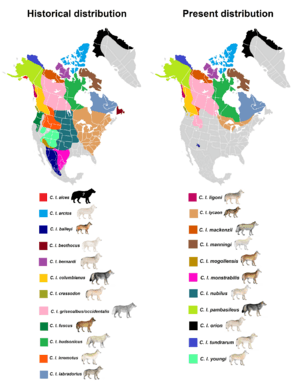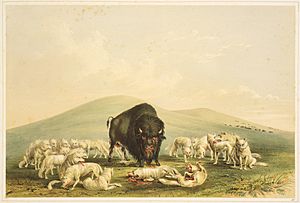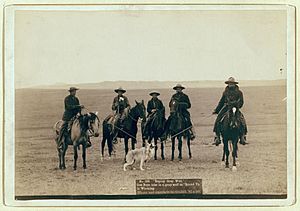Great Plains wolf facts for kids
Quick facts for kids Great Plains wolf |
|
|---|---|
 |
|
| Illustration based on a description by Edward Alphonso Goldman | |
| Conservation status | |
|
Extinct (1926)
|
|
| Scientific classification |
|
| Kingdom: | Animalia |
| Phylum: | Chordata |
| Class: | Mammalia |
| Order: | Carnivora |
| Family: | Canidae |
| Genus: | Canis |
| Species: | |
| Subspecies: |
†C. l. nubilus
|
| Trinomial name | |
| Canis lupus nubilus Say, 1823
|
|
 |
|
| Historical and present range of gray wolf subspecies in North America | |
| Synonyms | |
|
* variabilis (Wied-Neuwied, 1841) |
|
The Great Plains wolf (Canis lupus nubilus) was a type of gray wolf. It was also called the buffalo wolf or loafer. These wolves used to live across the Great Plains of North America. Their home stretched from southern Manitoba and Saskatchewan in Canada down to northern Texas in the United States. Sadly, this subspecies was declared extinct in 1926.
Great Plains wolves were known for being large. They often had light-colored fur, but their coats could vary. Some were all white, while others were all black. Native Americans from North Dakota shared stories. They said that just three of these powerful wolves could take down a huge bison.
Contents
How Scientists Classify the Great Plains Wolf
Scientists use a system called taxonomy to name and group living things. This helps us understand how different animals are related.
The Great Plains wolf was first described in 1823. A naturalist named Thomas Say wrote about it. He was on an expedition to the Great Plains. Say was the first to notice the difference between a "prairie wolf" (coyote) and this new wolf. He named it Canis nubilus.
Say described a wolf caught in a trap. He noted its dark, mottled fur with shades of gray and black. The wolf had short, dark ears and a blackish snout. Its legs were brownish-black. Say said this wolf looked much fiercer than a common red wolf or a prairie wolf. It also had a stronger, more robust body.
In 1995, a scientist named Robert M. Nowak studied wolf skulls. He suggested there were only five types of gray wolves in North America. He described C. l. nubilus as a medium-sized wolf. It lived from Texas to Hudson Bay and from Oregon to Newfoundland. However, this idea was not fully accepted by other scientists. The book Mammal Species of the World (2005) still lists this wolf as one of 27 subspecies of Canis lupus in North America.
Wolf Family Tree
Gray wolves (Canis lupus) traveled from Eurasia to North America. This happened between 70,000 and 23,000 years ago. They formed at least two different groups here. One group was the extinct Beringian wolf. The other group includes the wolves we see today.
Scientists study Mitochondrial DNA (mDNA) to learn about animal ancestry. mDNA is passed down from the mother. A study in 2005 looked at mDNA from modern wolves. It also looked at samples from wolves that lived between 1856 and 1915. These older samples came from the western United States, Mexico, and the Labrador Peninsula.
The study found that old wolf populations had more genetic variety. This means the wolves that disappeared from the western US had much more diverse mDNA. Some of the mDNA types found in the Mexican wolf, the extinct Southern Rocky Mountain wolf, and the Great Plains wolf were unique. They formed a special "southern group." All North American wolves are related to those from Eurasia. But this southern group is found only in North America. This wide spread of the southern group suggests that wolves moved and mixed genes across their territories a lot.
A study in 2018 looked at the leg bones of wolves. It compared modern wolves with ancient fossil wolves. The bones of the dire wolf, Beringian wolf, and most modern gray wolves are different. Ancient wolves from the Late Pleistocene (Ice Age) had shorter legs. This was true for wolves on both sides of the huge ice sheets. Modern wolves in the Midwestern USA and northwestern North America have longer legs. These longer legs developed later, during the Holocene period. This might have happened because their slower prey animals disappeared.
However, shorter legs continued to be seen in wolves even after the Ice Age. This was true even after many large Ice Age animals went extinct. The Mexican wolf (C. l. baileyi) and Great Plains wolf (Canis lupus nubilus) samples from before 1900 had shorter legs. They were similar to the ancient fossil gray wolves.
Life and Decline of the Great Plains Wolf

The Great Plains wolf lived across the Great Plains. This area stretched from southern Manitoba and Saskatchewan down to northern Texas. These wolves were large and often light-colored. Their fur could also be black and white, with some wolves being all white or all black. Males typically weighed about 100 lb (45 kg). The heaviest recorded male weighed 150 lb (68 kg). Their body length was about 1.7 m (5.6 ft).
Early records show that these wolves were very common. They were often seen throughout the Great Plains. Indians in North Dakota told stories. They said that just three of these wolves could bring down a large buffalo bull.
The pioneer Alexander Henry wrote about these wolves. He noted that they often ate buffalo carcasses. He also observed that the wolves were quite bold around humans. They sometimes came close to people and even entered tents while people slept. Henry recorded that Indians would dig up wolf pups from their dens. They also dug large pits to catch wolves and foxes. Members of Henry's group found wolf pups to be very tame and easy to train.
In 1833, Prince Maximilian of Wied-Neuwied also noted that these wolves were common. This was in the upper Missouri River area. Indians there used wolf pits. They traded wolves to him for tobacco. Maximilian found the local Indian dogs to be more dangerous than the wolves.
After the buffalo disappeared, the wolves lost their main food source. People then hunted them for their fur. They used poison and traps. By 1875, sightings of the wolf in North Dakota became rare. By 1887, they were almost gone. In Canada, bounties (rewards for killing wolves) started in 1878 in Manitoba. They began in 1899 in Saskatchewan and Alberta.
In North Dakota, two Great Plains wolves were seen in 1915. This sighting was by Remington Kellogg. The last known wolf was shot in 1922. The Great Plains wolf was officially declared extinct in 1926.
See also
 In Spanish: Lobo de las grandes llanuras para niños
In Spanish: Lobo de las grandes llanuras para niños


